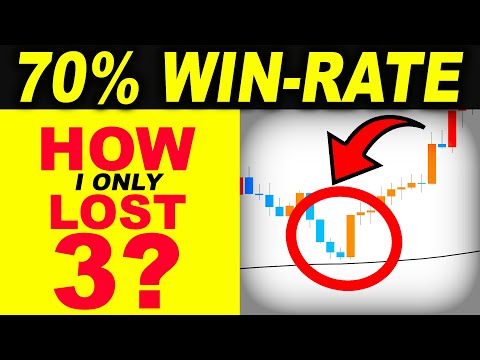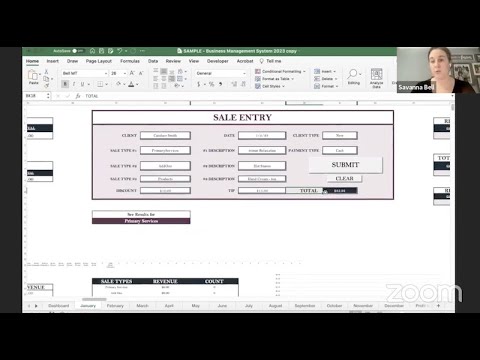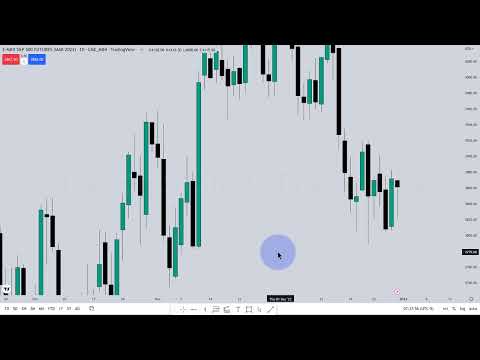How I got 70% Win Rate in Trading with this... Trading Strategy

Do you want to increase the winrate of your trading strategy? Do you want to take trades that have a very high probability of working? I had more than 70 percent win rate in the month of January, and on the Trading Rush Channel, I have tested many different trading strategies 100 times to see if they actually work or not. From MACD to Chaikin Oscillator and back to a MACD clone, but if you are a subscriber of the Trading Rush Channel, and have watched a couple of videos in the strategies tested 100 times series, you will notice that there is one indicator that is always recommended and used. In this video, I'm going to show you the simplest indicator that I use, and you should use if you want to increase the win rate of your trading strategy. Subscribe to the Trading Rush Channel and ring that
notification bell, because we test different strategies 100 times to find their win rates, and you don't want to lose your money with a strategy that doesn't even work. Imagine this, there is Bill the First and his broker. Bill the first goes to his broker to trade the orange stock. Obviously, he wants to trade the orange stock to make a profit. When Bill the first asks what the price of the orange stock is, the broker says
it's trading at 100 right now, but it made a low of 98 in the morning, so it is going up today. I don't care about what the price did today, show me the prices of the last 20 days, Bill the first says. 20 trading days is 4 weeks, and 4 weeks is one month. When the broker shows the data of the last 20 candles, Bill the first notices that the price was up at 120 dollars at one point, and it is currently trading at 100 dollars. Also right
now, it is trading below the 20 day average. Bill's trading guru told him to only buy when the price is above the 20 period moving average, and only sell when the price is below the 20 moving average. Bill is a quick learner and thinks that, if price is trading below the 20 day average, there is probably a selling pressure and price is in a downtrend. So he shorts the orange stock with a hope to make a profit when the price continues its downward trend. On the Way back home, he meets Bill the Second, another famous personality on this channel. Bill the first proudly says, I just shorted the orange stock because the price is in a downtrend.
No it's not, Bill the Second says. Yes it is, I did the analysis! I used the 4 weeks average to find the trend direction, and I found out that the price fell significantly in the last 4 weeks, and can continue to go down. Bill the second says, actually, if you look at the 40 weeks price data instead of 4 weeks, you will notice that the price went from 50 to 120 dollars, so the price is in a strong uptrend. And right now, the price is near the average of the last 40 weeks. So in other words, the price is near the 200 days average. Since price is in a strong uptrend, price near the last 200 days average is an excellent buying opportunity for many traders. So I'm
going to buy the stock as well. Instead of buying at the top, I am going to buy at the average price, as the 200 day average will act as a support. In other words, Bill the first has taken a short position where price has a higher probability of going up. The 200 Moving average is one of the key indicators for many traders to find the long term trend direction. If you watch some business news channels, you already know that news channels like to mention the 200 period moving average from time to time. "The stock has broken the
200 moving average support, where do you think the price is headed, dear expert?" But hold on a minute, what's so special about the 200 moving average? Why does everyone use it to find the long term trend direction? Well, there is nothing special about the 200 moving average. There is a saying, if enough people believe something is real even if it is not, it becomes real. Similarly, if many people see the 200 moving average as a support and resistance, it will work as a strong support and resistance. Or you can say, in an uptrend,
if many traders use the 200 moving average to take position at a fair and average price instead of buying at the top, it will create a buying pressure near the 200 moving average. Here's a real example, if enough redditors think that GameStop will go to the moon, it will go to the moon. As a stock options trader myself, and who has been lurking on wall street bets for a long time now, here's a tip for new traders who don't know what options are: Many traders in the wall street bets community are buying call options right now and making money as the price goes up. But once the price has reached the moon or Pluto, and it starts to correct itself, many in the wall street bets community are going to make money by purchasing puts. So if you are a beginner trader, it is a good idea to be on the same rocket ship that is also going to make money the way down.
In the month of January I had around 70 percent accuracy with stock options. Actually I had an 80 percent win rate because these two trades are actually one. I will talk about how I got such a high win rate in future videos. Maybe subscribe to the Trading Rush Channel
to see that. But one of the reasons the win rate was high, was because of the 200 period moving average. Normally, you use the 200 moving average to find the direction. If the price is staying above it, you say the price is in an uptrend and you buy when your trading strategy gives a buy signal. And if the price is staying below moving average, you say that the price is trending in the downward direction, and you sell when your trading strategy gives a short entry signal. But wait a minute, if your trading strategy gives a buy entry signal
in an uptrend, you are risking your money by looking at just one thing. Now I have tested many different trading strategies 100 times on the Trading Rush Channel, and many of them have a profitable win rate, and some even got win rates as high as 60 percent. And if you use a profitable strategy with the 200 period moving average, your chances of making money are pretty good, but what if the price comes down after you enter? If you know that the probability of increase in buying pressure near the 200 moving average is high, why not increase your probability of winning even more by combining your trading strategy with the 200 moving average? For example, here price is in an uptrend. It is staying above the 200 period moving average, and the moving average is not looking flat. Let's say you are using the MACD Strategy.
The MACD strategy we tested 100 times on the Trading Rush Channel, gave a high win rate with a 1.5 to 1 Reward Risk Ratio. If you don't know about the MACD Trading Strategy, check out the MACD video on this channel. According to the MACD strategy, we should only look for long entry signals when the price is above the 200 moving average. Here, price is above the moving average, and MACD is also giving a crossover signal. So the entry on this uptrend is right here. As you can see, price made an upward move, and you would have made money. But here's another example. The trend direction is still up, but price did not make an upward
move immediately after the MACD signal. If you would have set the stoploss very close to the pullback, you would have lost money. So what you can do is, if there is a 200 period moving average nearby, set your stoploss above or below it. In this case, since this is a long entry signal, instead of setting the stoploss just below the pullback, you can set it below the moving average and increase the probability of winning, because like I said before, the 200 moving average will act as a good support and resistance. In this uptrend, it will act as a support.
And when the price touched the 200 moving average, MACD gave another long entry signal, and this time the price made a big upward move. Now remember, I am showing you examples on the past data, because it will take forever for both good and bad setups to show up in the live market. But if you are supporting the Trading Rush Channel on Patreon, you already know that I do follow these rules while doing the analysis in the live market as well. This is one of the trade analysis I shared on Patreon. As you can see, here price was in an uptrend as well. When MACD gave an entry signal, the entry was near the MACD signal, and stoploss was below the 200 Exponential moving average and below the pullback. Now in this case,
the MACD signal appeared after price touched the 200 moving average, but since every entry signal will be different from the previous one, you are not going to get good setups everytime, where the entry signal was generated right after price touched the 200 moving average. Many times, the price will reverse without even touching the moving average. When that happens, or in other words, in an uptrend, when there is an entry signal just above the 200 moving average, I like to set the stoploss below the moving average to increase the probability of winning, as long as a good reward risk ratio is achieved before the next resistance.
For example, in this uptrend, MACD gave an entry signal, but the distance between MACD entry candle and the 200 moving average is too big. Here, if you set the stoploss below the moving average, you will have to increase your profit target distance as well to get a good reward risk ratio. But since price stays in a range most of the time, the chances of the price making a big move in your favor will be not high.
But when you see a setup like this, where MACD gave an entry signal very close to the 200 moving average, it is a good idea to set the stoploss below the moving average to increase the probability of winning. But remember, just because you set the stoploss below the 200 moving average, it doesn't guarantee your victory. Price still has a chance to break the 200 moving average support, and can do so if it wishes. In this setup, price is staying below the 200 moving average, so we know there is a downtrend going on. And in this downtrend, this is where the MACD is giving a short signal. Now you have two choices, either to set the stoploss above the pullback, or set the stoploss above the 200 period moving average, since the 200 moving average is also close to the pullback, and can also act as a resistance. Well, if you had used the 200 period moving average to set the stoploss, you would have increased the probability of winning, and would have made money, because the price touched the 200 E MA, and made a big move down.
If you look to the right however, price went in the downward direction after the MACD signal, without even touching or coming close to the moving average. That's why I said, every trade is different, and you will have to decide whether to go for a good reward risk ratio, or increase the probability of winning by sacrificing the good reward risk ratio. There is another method to increase the probability of making money in the forex and stock market. On this chart, price is in an uptrend. And in this uptrend, our trading strategy is giving
an entry signal right here. If there is a support area nearby, you can set the stoploss below it, instead of setting it below the pullback. And if the 200 E MA support is too far away, you can set the stoploss using only the support area as well. But if both support area and 200 moving average are nearby, your trade will have a very high probability of winning if you set the stop loss below both of them. Remember, I have already made a detailed video on how to draw support and resistance areas like a pro. Check it out on the Trading Rush
Channel to learn more. And like I said before, I follow the same rules in the live market as well. Here's another live trade analysis I shared on Patreon just two days ago. Here, the MACD entry was late,
so instead of setting a tight stoploss below the pullback, I set it below the 200 moving average support, and below the support area that was nearby. As you can see, price made an upward move and the profit target was hit. But what's the big deal with the 200 period moving average? Won't the 50 or 100 moving average have the same effect? In the last video where we tested the Faster MACD 100 times with the 200 moving average, and tested it again 200 times with a 50 day moving average, we found out that different moving averages don't change the win rate of a Trading Strategy significantly. If your trading strategy has a low winrate in the first place, using a different moving average probably won't turn your bad trading strategy into a profitable one. You can use a different moving average, but after trading in the live markets for a long time, I have found out that the 200 moving average works the best, and price is most likely to respect it, or in other words, there is high chance that the buying or selling pressure will increase near the 200 period moving average. It is a good idea to use the
same indicator settings that most traders will use, so you will see the same chart like most people. Here's what's going to happen when you will look at the same chart like most people: Lets say, on the daily timeframe, price made a move like this. It was in an uptrend, but at 15000, there was a huge selling pressure and price made a big move down. Now let's say there is bill the second. He went long near the end of this pullback using a
trading strategy like the MACD strategy. Now, there is bill the first, who thinks that the market is going to collapse, and wants to go short. Now if the price comes towards the 15000 mark again, bill the first will think that since the price will make a big move from the level, it is a good idea to sell here. But from bill the second's perspective,
three things can happen. Price can go up and break this resistance, or it can go sideways, or it can come down. Now remember, bill the second is already in profit because he bought down here. So if the price goes down again, he is going to give back his unrealised profit. But if he decides to book his profit when price comes near the strong resistance area, where many traders are likely to sell, he will have to create a sell order near the resistance area to close his long position. In other words, the buying pressure near the resistance area will decrease, and selling pressure will increase. Since the 15000 resistance
mark was clearly visible to most traders, many people made decisions based around it. Similarly, since many traders use the 200 period moving average, there is a high probability that there will be an increase in trading activity near it. Now one might say: Well, what about Fibonacci levels then? You said use the normal support and resistance instead of using it. But if enough people believe that Fibonacci works in trading, it should work right? Well yes, but that's not the problem with Fibonacci. You see, Fibonacci is a tool similar to the VWAP indicator used to find the potential reversal point. But the problem with Fibonacci is, you have to draw the Fibonacci levels
by yourself using the swing high and swing low. And not everyone is going to draw the Fibonacci levels the same way. Many are going to identify the swing low or swing high differently. Imagine that there is only one timeframe in the entire world. Let's say everyone uses the daily timeframe. Now, everyone will see the 200 moving average support on the same
price, but since movement is not always clean, and everyone looks at swing lows and swing highs differently, Fibonacci levels will still be at slightly different levels for everyone. Now if you use Fibonacci with your trading strategy, good for you. But in my experience, support and resistance areas that everyone can see at the same price works really well. For example, let's say the price reversed from a 1000 dollars price level, and then gave a breakout above it. Now this resistance will act as a support area, and everyone on
all timeframes can see the 1000 support at the same place. Then there are Fibonacci traders, who will draw the multiple Fibonacci levels slightly differently. Now ask yourself this, which chart do you prefer. The one where most people are looking to buy at the same price level. Or the one where people are looking at multiple levels. Some once said, keep your
trading simple, because it is nothing more than buying at support and selling at resistance. But one might say, you have to wait for an entry signal near the Fibonacci levels. Well, lets say, there are two tracks. On the first track, there is one stop sign. And on the second track, there are 6 stop signs. Now, let's say there are two cars, and you
have one chance to bet at what stop sign the car will stop. You can look at its tail, to see if the driver is hitting the brakes or not. Let's say the driver of the first car has a completely random name, Richard. And the driver of the second car is called, James. Now when the car came towards the first stop sign on the second track, it didn't break.
So you didn't take any position. But when it comes near the second stop sign on the second track, the brake light turns on. Now this is your entry signal. The price is near the stop sign on the second track and it is breaking. So some people who are looking at the second track will bet that the car will stop at this stop sign. But some can decide to hold back, because there are still many stop signs ahead, so maybe the car will stop at the next one. On the first track, since there is only one stop sign that is still far away, no one is ready to bet right now. When the car does not stop at the second stop
sign and directly slows down at the 5th stop sign, some people are betting and some are not on the second track. People on the first track are calmly waiting for the car to come near the stop sign, while James on the other hand can't decide on what stop sign to stop. But when the second car comes near the last stop sign, everyone who was holding back before will bet now as this is the last stop sign. People who risked their money at the previous stop signs, lost money. On the other hand, since there is only one stop sign on the first track, everyone is going to bet at the same time. And if the cars stop at the last stop
signs, they are going to make money. The second track is similar to the Fibonacci or any other complicated trading strategy. But the first track is similar to a strong higher timeframe support resistance level, that everyone will most likely see at the same price. By keeping
trading simple, and by taking trades at the clearly visible support and resistance and near the 200 period moving average, you can increase the win rate of your trading strategy. That's all. Like the video if you liked it. Subscribe to the Trading Rush Channel and ring that notification bell, to see more videos like this one, and because we test and have tested different strategies 100 times to find win rates, and you don't want to lose your hard earned money with a strategy that doesn't even work. Support Trading Rush Channel on
Patreon and get to see in-depth trade analysis. And thanks for watching.
2021-02-03 23:27


